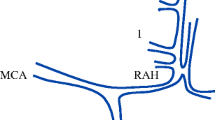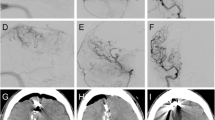Summary
Regional cerebral blood flow, recorded by the133Xenon inhalation method, was measured preoperatively and over a five years postoperative period in six patients with completed stroke and stabilized neurological deficits, who had undergone omental transposition for revascularization of the ischaemic brain. Comparisons of the preoperative blood flow values with those recorded following surgery demonstrate a postoperative increase of blood flow in five patients, with a high statistical degree of significance in four of them at the final examination. The flow increase was noted over the infarcted areas of the brain, upon which the omentum had been placed, as well as areas of the ischaemic hemisphere without omental placement and the contralateral hemisphere. Out of the five patients who demonstrated preoperative flow values below the expected norm for age, four showed final postoperative cerebral blood flow within the normal limits for their age. The results are consistent with the assumption that the transposed omentum played a role in postoperative blood flow increase, by adding collateral circulation to the ischaemic brain.
Similar content being viewed by others
References
Allcock JM (1967) Occlusion of the middle cerebral artery: serial angiography as guide to conservative therapy. J Neurosurg 27: 353–363
Azzena GB, Campus G, Mameli O, Moraglia S, Padua G, Pau A, Pau S, Ruju P, Sehrbundt Viale E, Tolu E, Turtas S, Viale GL (1983) Omental transposition or transplantation to the brain and superficial temporal artery-middle cerebral artery anastomosis in preventing experimental cerebral ischaemia. Acta Neurochir (Wien) 68: 63–83
Berger MS, Weinstein P, Zhea E, Goldsmith HS (1990) Bypassing blood brain barrier with omental transposition: a new technique for chemotherapy administration for malignant brain tumors. In: Goldsmith HS (ed) The omen tum—research and clinical applications. Springer, Berlin Heidelerg New York, pp 117–129
Blauenstein UW, Halsey JH, Wilson EM, Wills EL, Risberg J (1977) 133-Xenon inhalation method: analysis of reproducibility. Some of its physiological implications. Stroke 8: 92–102
Cucca GS, Papavero L, Pau A, Sehrbundt Viale E, Turtas S, Viale GL (1980) Effect of omental transposition to the brain on protein synthesis in experimental cerebral ischaemia. Acta Neurochir (Wien) 51: 253–257
Dalle Ore G (1989) Personal communication
Day AL (1983) Symptomatic MCA obstruction: clinical and radiographic features (abstract). Stroke 14: 124
Demeurisse G, Verhas M, Capon A, Paternot J (1983) Lack of evolution of the cerebral blood flow during clinical recovery of a stroke. Stroke 14: 77–81
De Riu PL, Falzoi A, Papavero L, Rocca A, Viale GL (1980) Local cerebral blood flow after middle cerebral artery occlusion in rabbits following transplantation of omentum to the brain. J Microsurg 1: 321–324
De Riu PL, Rocca A, Falzoi A, Carai M, Papavero L (1980) Physiological function after middle cerebral artery occlusion in rabbits with neovascularization of the brain by transposed omentum. Neurosurgery 7: 157–160
De Weerd AW, Veering MM, Mosman PCM, van Huffelen AC, Tulleken CAF, Jonkman EJ (1982) Effects of the extra-intracranial (STA-MCA) arterial anastomosis on EEG and cerebral blood flow. Stroke 13: 674–679
Dong YR, Lin YJ, Li YH (1983) Transplantation of free omental flaps to the brain surface by microvascular technique for cerebral ischemic stroke. Chung Hua Wai Ko Tsa Chih 16: 23–25
Downie NM, Heath RW (1974) Basic statistical methods. Harper & Row Publishers Inc, New York
Fujishima M, Nishimaru K, Omae T (1977) Long-term prognosis for cerebral infarction in relation to brain circulation. A 7-year follow-up study. Stroke 8: 680–683
Goldsmith HS, Chen WF, Duckett S (1973) Brain vascularization by intact omentum. Arch Surg 106: 695–698
—, Duckett S, Chen WF (1975) Prevention of cerebral infarction in the dog by intact omentum. Amer J Surg 130: 317–326
— — — (1978) Prevention of cerebral infarction in the monkey by omental transposition to the brain. Stroke 9: 224–229
—, Saunders RL, Reeves AG, Allen CD, Milne L (1979) Omental transposition to brain of stroke patients. Stroke 10: 471–472
—, Griffith AL, Kupferman A, Catsimpoolas N (1984) Lipid angiogenic factor from omentum. JAMA 252: 2034–2036
- (1986) Omental transposition to the brain and spinal cord. Surgical Rounds, 22–23 June, 1986
—, Griffith. AL, Catsimpoolas N (1986) Increased vascular perfusion after administration of an omental lipid fraction. Surg Gynecol Obstet 162: 579–583
—, Marquis JK, Siek G (1987) Choline acetyltrasferase activity in omental tissue. Br J Neurosurg 1: 463–466
—, McIntosh T, Vezina RM, Colton T (1987) Vascoactive neurochemicals identified in omentum. Br J Neurosurg 1: 359–364
Gur RC, Gur RE, Obrist WD, Skolnick BE, Reivich M (1987) Age and regional cerebral blood flow at rest and during cognitive activity. Arch Gen Psychiatry 44: 617–621
Halsey JH, Morawetz RB, Blauenstein UW (1982) The hemodynamic effect of STA-MCA bypass. Stroke 13: 163–167
Hartmann A, Menzel J, Rommel T, Winter R (1983) Regional cerebral blood flow in patients with extra-intracranial bypass operation (Abstract). Acta Neurochir (Wien) 68: 151.
Herold S, Frackoviak R, Neil-Dwyer G (1987) Studies on cerebral blood flow and oxygen metabolism in patients with established cerebral infarct undergoing omental transposition. Stroke 18:46–51
Hutchinson EC, Acheson EJ (1975). In: Strokes. Natural history, pathology and surgical treatment. WB Saunders Company Ltd, London Philadelphia Toronto, pp 138–153
Ishihara N, Meyer JS, Deshmukh VD, Hsu MC (1977) Noninvasive measurements of regional cerebral blood flow (rCBF) in man. Normal values, effects on age, cerebral dominance and activation (abstract). Neurology 27: 401
Karasawa Y, Kikuchi H, Kawamura Y, Sakai T (1980) Intracranial transplantation of the omentum for cerebrovascular moya-moya disease. A two-year follow-up study. Surg Neurol 14: 444–449
Laurent JP, Lawner PM, O'Connor M (1982) Reversal of intracerebral steal by STA-MCA anastomosis. J Neurosurg 57: 629–632
Liu JF, Wang ZZ, Liu YT (1980) Intracranial transposition of pedicled omentum in the management of ischemic cerebrovascular diseases. J Nerv Ment Dis 6: 321–323 (in Chinese)
Marshall J, Kaeser AC (1961) Survival after non-haemorrhagic cerebrovascular accidents. A prospective study. Br Med J 2: 73–77
Melamed E, Lavy S, Bentin S, Cooper G, Rinot Y (1980) Reduction in regional cerebral blood flow during normal aging in man. Stroke 11: 31–35
Meyer JS, Nakajima S, Okabe T, Amano T (1982) Redistribution of cerebral blood flow following STA-MCA bypass in patients with hemispheric ischemia. Stroke 13: 774–784
Naritomi H, Meyer JS, Sakai F, Yamaguchi F, Shaw T (1979) Effects of advancing age on regional cerebral blood flow. Arch Neurol 36: 410–416
Ni MS, Zou XW, Xie KM (1983) Free omental autotransplant to brain surface in ischemic cerebrovascular disease. Chin Med J 96: 787–789
Obrist WD, Thompson HK, Wang HS, Wilkinson WE (1975) Regional cerebral blood flow by 133-Xenon inhalation. Stroke 6: 245–256
Onesti ST, Soloman RA, Quest OO (1989) Cerebral revascularization: a review. Neurosurgery 25: 618–629
Pau A, Sehrbundt Viale E, Turtas S, Viale GL (1980) Cerebral water and electrolytes in experimental ischaemia following omental transposition to the brain. Acta Neurochir (Wien) 54: 213–218
— — — (1982) Effect of omental transposition on to the brain on the cortical content of norepinephrine, dopamine, 5-hydroxytriptamine and 5-hydroxyindolacetic acid in experimental cerebral ischaemia. Acta Neurochir (Wien) 66: 159–164
Prohovnik I, Hakansson K, Risberg J (1980) Observations on the functional significance of regional cerebral blood flow in resting normal subjects. Neuropsychologia 18: 203–217
Risberg J, Ali Z, Wilson EM, Wills EL, Halsey JR(1975) Regional cerebral blood flow by 133-Xenon inhalation. Preliminary evaluations of an initial slope index in patients with unstable flow compartments. Stroke 6: 142–148
Rodriguez G, De Carli F, Novellone G, Marenco S, Rosadini G (1988) Regional cerebral blood flow measurements using the 133-Xenon inhalation method. In: Rescigno A, Boicelli A (eds) Cerebral blood flow. Plenum Press, New York, pp 121–143
Rodriguez G, Cogorno P, Gris A, Marenco S, Mesiti C, Nobili F, Rosadini G (1989) Regional cerebral blood flow and anxiety: a correlation study in neurologically normal patients. J Cereb Blood Flow Metab 9: 410–416
Rosadini G, Cossu M, De Carli F, Marenco S, Nobili F, Rodriguez G (1989) Evaluation of cerebral blood flow data in stroke patients using a mapping system. Stroke 20: 1182–1189
Sandini G, Rodriguez G, Romano P, Rosadini G (1986) Topographic mapping of rCBF data. In: Battistin L, Gerstenbrand F (eds) PET and NMR: new perspectives in neuroimaging and clinical neurochemistry. Alan R Liss, Inc, New York, pp 191–202
Shaw TG, Mortel KF, Meyer JS, Rogers RL, Hardenberg J, Cutaia MM (1984) Cerebral blood flow changes in benign aging and cerebrovascular disease. Neurology 34: 855–862
Siegel S (1976) Non-parametric statistics for the behavioral sciences. McGraw-Hill, New York
Siek G, Marquis JK, Goldsmith HS (1990). Experimental studies of omentum-derived neurotrophic factors. In: Goldsmith HS (ed) The omentum — perspectives and clinical applications. Springer, Berlin Heidelberg New York, pp 83–95
Sinderman F, Dichgans J, Bergleiter R (1969) Occlusion of the middle cerebral artery and its branches: angiographic and clinical correlates. Brain 92: 607–620
Symon L (1988) The use of cerebral blood flow measurements in clinical neurosurgery. In: Knezevic S, Maximilian VA, Mubrin Z, Prohovnik I, Wade J (eds) Handbook of regional cerebral blood flow. LEA Publishers, Hillsdale, New Jersey, pp 197–218
Tanahashi N, Meyer JS, Rogers RL, Kitigawa Y, Mortel KF, Kandula P, Levinthal R, Rose J (1985) Long term assessment of cerebral perfusion following STA-MCA bypass in patients. Stroke 16: 85–91
Thomas M, Hennerici M, Marshall J (1984) Cerebral blood flow after carotid occlusion and extracranial-intracranial bypass. J Neurol Neurosurg Psychiatry 47: 148–152
Wang CC, Chao YT, Jung DA (1985) Omentum transplantation and revascularization. In: Bignami A, Bloom FE, Bolis CG, Adeloyle A (eds) Central nervous system plasticity and repair. Raven Press, New York, pp 159–163
Warach S, Gur RC, Gur RE, Skolnick BE, Obrist WD, Reivich M (1987) The reproducibility of the 133-Xenon technique in resting studies: Task order and sex-related effects in healthy young adults. J Cereb Blood Flow Metab 7: 702–708
Yamahoka S, Takagi Y, Okada T, Saita Y (1972) Relationship of serial measurements of cerebral hemodynamics to prognosis in patients with hypertension and cerebrovascular disease. Stroke 3: 57–66
Yaşargil MG, Yonekawa Y, Denton J, Piroth D, Benes I (1974) Experimental intracranial transplantation of autogenous omentum majus. J Neurosurg 40: 213–217
Yonekawa Y, Yaşargil MG (1977) Brain vascularization by transplanted omentum: a possible treatment of cerebral ischemia. Neurosurgery 1: 256–259
Younkin D, Hungerbuhler JP, O'Connor M, Goldberg H, Burke A, Kushner M, Hurtig H, Obrist WD, Gordon J, Gur R, Reivich M (1985) Superficial temporal-Middle cerebral artery anastomosis: effects on vascular, neurologic, and neuropsychological functions. Neurology 35: 462–469
Zhang C (1983) Intracranial free omentum with microsurgical technique in the treatment of ischemic cerebrovascular disease. Chung Hua Shen Ching Ching Shen Tsa Chih 16: 23–25
Zhu ZC, Wu WL, Mo YZ (1982) Omental transposition to the brain of cerebrovascular occlusive disease. Chung Hua Wai Ko Tsa Chih 20: 11–13
Author information
Authors and Affiliations
Rights and permissions
About this article
Cite this article
Goldsmith, H.S., Bacciu, P., Cossu, M. et al. Regional cerebral blood flow after omental transposition to the ischaemic brain in man. A five year follow-up study. Acta neurochir 106, 145–152 (1990). https://doi.org/10.1007/BF01809458
Issue Date:
DOI: https://doi.org/10.1007/BF01809458




